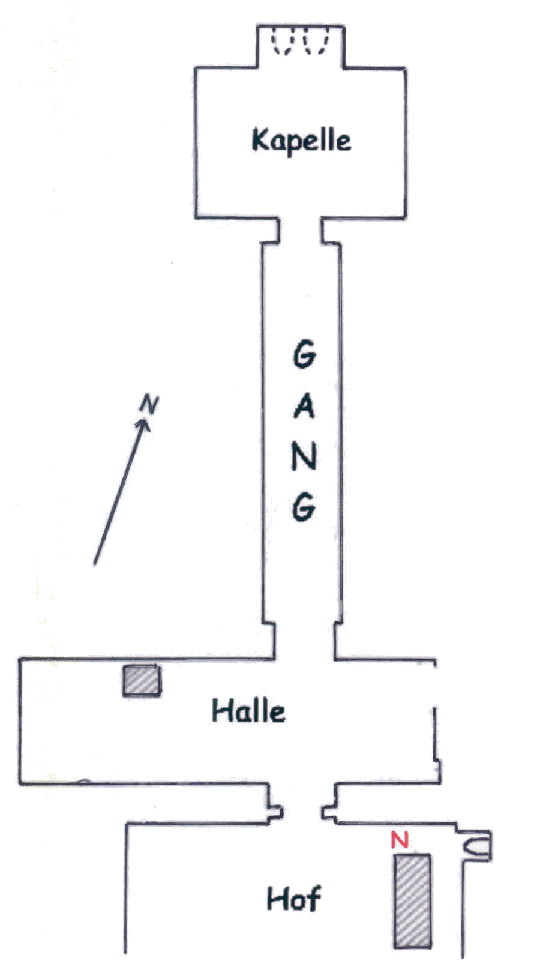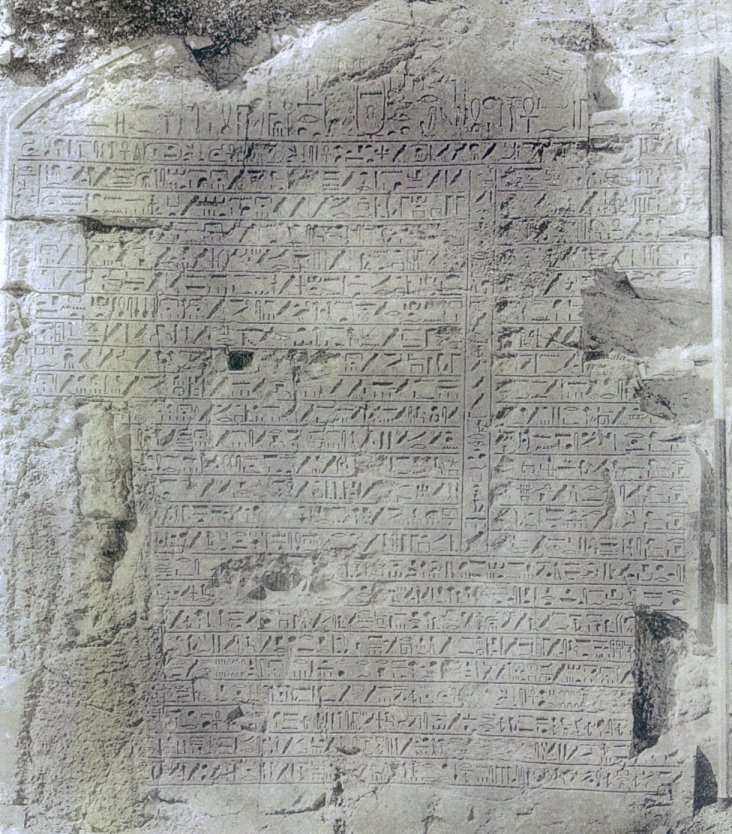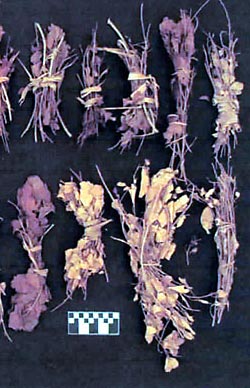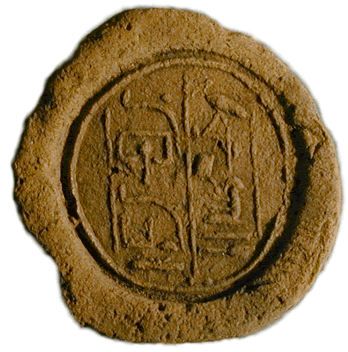 |
Djehutj |
last update:
26.03.2008
|
Historical Data
| Name
|
Title
|
|
Origin
|
Tomb
|
Djehutj / Dhout
+Hwtj
|
Overseer of the Treasury, Overseer of the
Craftsmen |
|
Hermopolis |
TT11 (P&M I-1, 21; at Dra Abu el-Naga) |
| Parents
|
|
|
|
|
| Father: |
|
|
|
|
| Mother: Dedju
|
|
|
|
|
| Brother(s): |
|
|
|
|
| |
|
|
|
|
| Sister(s):: |
|
|
|
|
| |
|
|
|
|
|
The tomb of Djehutj, TT11, is located in the area of Dra Abu el Naga , approximately half
the way down the road from the temple of Hatshepsut to the Valley of
Kings. The tomb was opened among others by the
Marquis of Northampton, Spiegelberg, and Newberry in the winter season 1898-1899.
|

|
Floor plan of Djehuti's (Dhout) tomb, TT11
|
|
The tomb (see floor plan above) consists of a forecourt (= Hof), in which the "Northampton-Stela"
(illustrated below) is to be seen at the position N, a hall (= Halle),
with a break-through at their eastern side (to tomb TT12, owned by Hray,
who lived during the times of Ahmose - Amenhotep I.), and a long corridor
(= Gang), which finally ends in a chapel (= Kapelle).
|
|
In the forecourt of the tomb the so-called "Northampton-Stela" (s.
fig. below) was cut into the rock on the right side of the forecourt, right from the
entrance to hall. Also on the north wall of the forecourt, but left of the
entrance are the remainders of another stela, which shows the deceased
adoring Amun - but the upper part of the stela is destroyed.
|

| Photo of the so-called "Northampton-Stela", in
the tomb of the Overseer of the Treasury, Djehutj, TT11 (published in Marquis of Northampton, Spiegelberg, W.,
Newberry, P.E., 1908, Plate I). On the lower left side there are still traces of
the destroyed figure of Djehutj to be seen.
|
|
The upper rounded part of the "Northampton-Stela" contains two cartouches, on the right
the cartouche of Thutmosis III. ("Men-kheper-Ra", which is still readable) and on the left of it
the destroyed cartouche of Hatshepsut. The text is to be read from left to
right, therefore, the cartouche of Hatshepsut is placed before that of Thutmosis
III..
|
|
Below the rounded top of the stela the text starts in the first row with a praise of Amun-Ra and continues
with a list of titles and duties of Djehutj. Rows 2 to 16 of the
autobiographical text always start with the name and a title of Djehutj
followed by the name of a building or a piece of equipment he had been
responsible for. Both horizontal parts are separated by a vertical line of
text which always is to read as a link: "He says, I have been the
head who gave the instructions; I have directed the workman so that they
had worked in accordance with the order at..."
|
|
In the 4th row he reports about his activities at Djeser djeseru:
"jrj-pa.t, HAtj-a,
Djehutj who directed the workmen to do their job he said:
"I have been the director who had given instructions. I directed the
workmen so that they had worked in accordance with the order at
"Djeser djeseru, the House of Million of Years". Its great doors
had been made of copper, figures and ornaments were made of electron. The
king of Upper and Lower Egypt, Maat-ka-Ra, has made this [as a monument for
his father, Amun, Lord of the Thrones of the Two Lands. May he live
forever like Ra]." |
| Among the numerous duties, for which Djehutj claims the responsibility he mentions the
work on two obelisks in the temple of Amun (Karnak) - in his own words:
"I have been the highest commander, who had given the orders. I
have led the craftsmen during their work on both large obelisks, which
were 108 ells in length and which were covered completely with electron. They
have given light to all Egypt."
However, the inscriptions does not identify the pair of
obelisks, the eastern one or the western pair in the hall of Wadjit, he
was talking about.
|
| Since the discovery of the stela numerous attempts had
been made to identify the pair of obelisk for which Djehutij had been
responsible whereby the information of the text as well as the information
about the obelisks given in Djeser djeseru and in the
Red Chapel was used.
Besides the mentioned length of 108 ells and the question which ell was
meant here, also the question whether the length of 108 ells referred to a
single one or to the combined length of two obelisks played a central role.
During the construction of the Red Chapel an ell of 0.524 ms was used,
during the construction of 8. Pylons one of 0.53 ms, i.e. the
108 ells mentioned by Djehutj corresponds to a length (heigth) of 56.7 or 57.24 ms.
|
| Comparisons of measures of length (base surfaces,
length of the pyramidions, etc.) from preserved obelisks, including the "incomplete
obelisk" at Aswan, excluded with great certainty that this length has
referred to a single obelisk. For example, all known bases of obelisks
would be too small to carry an obelisk of 108 ells in length. Furthermore,
there are certain doubts about whether the Egyptians were technical able
at the times of Hatshepsut, to manufacture obelisks of that length.
|
| Obviously, archaeological findings and descriptions
concerning the length of the sides covered with electrum are more helpful.
Lacau has examined the preserved fragments of the eastern obelisks of
Hatshepsut and has found no traces of a covering of the shaft with a
valuable material. Furthermore, the dedication text in the Hall of
Obelisks in Djeser djeseru reports that the obelisk which was erected
in the east of the temple of Karnak only had been decorated with
electrum on its pyramidion. Thus, the assumption that the report of
Djehutj referred to the 1st (eastern) pair of Hatshepsut can be hardly
maintained.
|
Archaeological findings and epigraphs argue in favor for
the fact that the text of Djehutj refers to both western obelisks which
Hatshepsut had erected in the Wadjit hall between the 4th and 5th pylon.
Lacau discovered that inside the
p.t,
tA, and
wAs signs which frame the
sides of the shaft very thin, deep grooves exists - obviously to fix an
electrum foil over more than half of the length of the obelisk. Also the
inscription on the base of the still standing (northern) obelisk of
Hatshepsut reports:
"She made (this) as her monument for her father Amun, Lord of the Thrones
of the Two Lands, the foremost of the temple of Karnak, [namely] the
making of two great obelisks from the hard granite of the southern region,
their upper halves being of electrum from the best of all foreign
countries ... ". |
Furthermore, Djehutj lists extensively, which activities or constructions
had been executed under his command in the area of Waset (Thebes) for Amun:
a shrine, a gate, doors at "Appearance of the
Clarified", the renovation of the floor in Ipt-swt (Karnak temple), a shrine
made of ebony with stairs, two doors at Karnak, jewelries, two obelisks,
the gate "The Appearance of Amun in the Morning", several
offering tables, boxes, containers, dresses and a shrine made of granite.
|
| Finally, he was also responsible - based on the
inscriptions - for the registration of the "tributes" from Punt at their
arrival, and in fact, a half destroyed scene in the Hall
of Punt at Djeser djeseru actually shows him "calculating"
the amount of incense piled up in front of him.
|
| The stela ends with a prayer for himself. |
|
Also in the forecourt, inside a niche which is located on the right side
of the "Northampton-Stela" there is standing another statue of the deceased,
this statue carries a donation text on its apron.
|
|
Inside the hall the deceased is shown on numerous relief together with his
mother Dedju. It is possible, that he is shown on a door jamb together
with his father who is walking in front of him, both adoring Amun-Ra but
the identification of the figure is not proven.
|
|
Inside the corridor the deceased is shown in several offering scenes,
hunting the Wild Bull, and during the pilgrimage to Abydos.
|
|
While cleaning the debris in the open courtyard of the tomb the Spanish-Egyptian archaeological team
working in TT11
found a 70 cm deep pit containing 42 clay vases and 42 flower bouquets.
|
| These are most likely the remains of the funerary bouquets of Djehutj
which were later thrown into this pit. A contemporary scene carved on the walls
of the burial chamber shows participants at the funeral bringing in bouquets and
vases of flowers. The photo below shows some example of the flowers found (photo
by: Al-Ahram Weekly Online, 29 March - 4 April 2007, issue No. 838).
|

|
In Porter and Moss, Vol. I-1, numerous findings, among them a golden dish,
today in the Louvre, and a splendor dagger, today in the museum at Darmstadt, are listed and assigned to the Djehutj presented here. These,
and possibly the others objects mentioned in Porter and Moss, probably
belong to the general Djehutj, who has served under Thutmosis III and
taken the town of Joppe. The general Djehutj is not identical with the
Djehutj presented here. General Djehutj was buried at Saqqara.
|
|

|
|
Funerary cone of the "Overseer of
the treasury, overseer of all work, Djehutj, justified", diameter 8 cm, length
3.4
cm;
Source: Petrie Museum, London U37678
|
|



